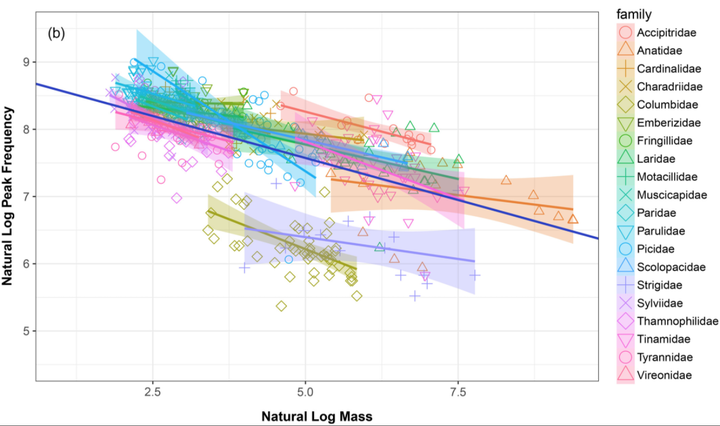Testing the strength and direction of selection on vocal frequency using metabolic scaling theory
 Log-log scaling of vocal frequency with mass for 795 bird species
Log-log scaling of vocal frequency with mass for 795 bird speciesAbstract
A major challenge for studies assessing drivers of phenotypic divergence is the statistical comparison of taxa with unique, often unknown, evolutionary histories, and for which there are no clear expected trait values. Because many traits are fundamentally constrained by energy availability, we suggest that trait values predicted by scaling theories such as the metabolic theory of ecology (MTE) can provide baseline expectations. Here, we introduce a metabolic scaling-based approach to test theory involving the direction and magnitude of ecological and sexual selection, using vocal frequency as an example target of selection. First, we demonstrate that MTE predicts the relationship between the natural log of body size and natural log of vocal frequency across 795 bird species, controlling for phylogeny. Family-wide deviations in slope and intercepts from MTE estimates reveal taxa with potentially important differences in physiology or natural history. Further, species-level frequency deviations from MTE expectations are predicted by factors related to ecological and sexual selection and, in some cases, provide evidence that differs from current understanding of the direction of selection and identity of ecological selective agents. For example, our approach lends additional support to the findings from many cross-habitat studies that suggest that dense vegetation selects for lower frequency signals. However, our analysis also suggests that birds in non-forested environments vocalize at frequencies higher than expected based on MTE, prompting intriguing questions about the selective forces in non-forest environments that may act on vocal frequency. Additionally, vocal frequency deviates more strongly from MTE expectations among species with smaller repertoires and those with low levels of sexual dichromatism, complicating the use of these common sexual selection surrogates. Broad application of our metabolic scaling approach might provide an important complementary approach to understanding how selection shapes phenotypic evolution by offering a common baseline across studies and taxa and providing the basis to explore evolutionary trade-offs within and among multicomponent and multimodal traits.
This paper was a side project Clint and I hatched at a conference back in 2012 while I was a grad student and he was a postdoc at the now defunct National Evolutionary Synthesis Center (NESCent) at Duke. I got a semester graduate fellowship to work on this at NESCent in the spring of 2013, during which time Clint got a position as Assistant Professor at San Luis Obispo. This project has dogged us for the interceding 8 years, and the manuscript has adapted through a challenging process of rejection and revision at several different journals. We are very excited to finally see it published open access and hope it will stimulate some interesting work exploring the variation around metabolic scaling relationships of behavioral traits in an evolutionary context.